« The DAS scandals | Main | Uribe's opponents' security problem »
April 15, 2006
Colombian coca cultivation in 2005
Here is a memo (PDF format) CIP is sending out to media, congressional staff and other colleagues this morning.
At 5:00 yesterday, Good Friday, the U.S. government announced that coca cultivation in Colombia last year totaled 144,000 hectares, a level not seen since 2002. While this appears to be a 30,000-hectare increase over 2004 levels, the White House Drug Czar’s press release cautions that much of the increase owes to newly discovered coca in areas that U.S. satellites were not monitoring before.
No matter what the reason for the huge increase measured in 2005, the following points are indisputable.
1. According to an October 2000 White House report, “The goal of President Pastrana’s Plan Colombia (October 1999) is to reduce Colombia’s cultivation, processing, and distribution of drugs by 50 percent over six years.” The 2005 coca-cultivation figures reported yesterday show that Plan Colombia has demonstrably failed to reach that goal. It hasn’t even come close.
The figure of 144,000 hectares in 2005 exceeds the U.S. government’s measures of Colombian coca-growing in 1999, the year before Plan Colombia began (122,500 hectares), and 2000, the plan’s first year (136,200 hectares).
Even if we accept the U.S. government’s argument that the high 2005 estimate owes to measurement in new areas, it is impossible to claim that Plan Colombia has brought a 50 percent reduction in coca-growing in six years. It cannot plausibly be claimed that better measurement would have shown coca-growing to be twice as extensive – 288,000 hectares – in 1999 and 2000.

|
| 1997 | 1998 | 1999 | 2000 | 2001 | 2002 | 2003 | 2004 | 2005 |
| Colombia | 79,500 | 101,800 | 122,500 | 136,200 | 169,800 | 144,400 | 113,850 | 114,000 | 144,000 |
| Peru | 68,800 | 51,000 | 38,700 | 34,100 | 34,000 | 36,600 | 31,150 | 27,500 | 38,000 |
| Bolivia | 45,800 | 38,000 | 21,800 | 14,600 | 19,900 | 21,600 | 23,200 | 24,600 | 26,500 |
| Total | 194,100 | 190,800 | 183,000 | 184,900 | 223,700 | 202,000 | 168,200 | 166,100 | 208,500 |
|
| 1988 | 1989 | 1990 | 1991 | 1992 | 1993 | 1994 | 1995 | 1996 |
| Colombia | 34,000 | 42,400 | 40,100 | 37,500 | 37,100 | 39,700 | 44,700 | 50,900 | 57,200 |
| Peru | 115,530 | 121,685 | 121,300 | 120,800 | 129,100 | 108,800 | 108,600 | 115,300 | 94,400 |
| Bolivia | 48,925 | 52,900 | 50,300 | 47,900 | 45,500 | 47,200 | 48,100 | 48,600 | 48,100 |
| Total | 198,455 | 216,985 | 211,700 | 206,200 | 211,700 | 195,700 | 201,400 | 214,800 | 199,700 |
2. The figure of 144,000 hectares in 2005 represents the most coca measured in Colombia since 2002, when the U.S. government reported 144,400 hectares. That was the second-highest year ever.
Either Colombia has returned to this level of cultivation, or the “reductions” reported in 2002 and 2003 were false due to poor measurement. If the reductions were false, then U.S. officials for several years have unwittingly made false and misleading claims about the success of aerial fumigation in Colombia. Three of many examples:
o Testimony of Assistant Secretary of State for International Narcotics Robert Charles, October 29, 2003: “One of Plan Colombia's goals was to reduce coca cultivation by 50% by 2005. President Uribe's aggressive support for spraying, and the professionalism and efficiency of State Department contractors may well have put us ahead of that mark.”
o February 27, 2003 press release from the Drug Czar’s office regarding 2002 coca reduction: “These figures capture the dramatic improvement attributable to activities to control coca production that commenced in August with the inauguration of President Uribe. … ‘Our anti-drug efforts in Colombia are now paying off, and we believe that this represents a turning point,’ said John Walters, Director of National Drug Control Policy.”
o Testimony of Assistant USAID Administrator for Latin America Adolfo Franco, May 11, 2005: “The reduction of coca cultivation in the region has been most significant in Colombia. Aerial eradication has impressively reduced regional production capacity and has raised pressure on traffickers to bear the cost of replanting and field reconstitution. … As the final year of Plan Colombia comes to an end, however, success is measurable and is a good reason to redouble efforts on programs that have caused traffickers the greatest damage.”
3. The U.S. government’s 2005 estimates for the three principal Andean coca-producing countries – Colombia, Bolivia and Peru – show that 208,500 hectares of coca were grown in the Andean region last year. That is the highest estimate since 2001. It is the sixth-highest estimate in the 18 years since 1988.
4. 2005 was the first year since 1995 that U.S. data showed coca increasing simultaneously in all three Andean countries.
5. Attempted coca production in Colombia – defined as eradicated plus uneradicated coca – has surged from 183,500 hectares in 2000 to 315,400 hectares in 2005. That’s a five-year increase of 72 percent. In response to fumigation, growers have cut down forests and planted coca in 72 percent more territory last year than they did in 2000, including in national parks. That – more than the effects of glyphosate – is the real environmental disaster brought by fumigation.
The Andean region as a whole has seen attempted coca cultivation increase 62 percent, from 246,124 hectares in 2000 to 398,100 hectares in 2005.

|
| 1996 | 1997 | 1998 | 1999 | 2000 | 2001 | 2002 | 2003 | 2004 | 2005 |
| Uneradicated Coca Colombia | 57,200 | 79,500 | 101,800 | 122,500 | 136,200 | 169,800 | 144,400 | 113,850 | 114,000 | 144,000 |
| Eradication Colombia | 5,600 | 19,000 | 31,123* | 43,246 | 47,371 | 84,251 | 122,695 | 132,817 | 136,555 | 171,400 |
| Uneradicated Coca Peru | 94,400 | 68,800 | 51,000 | 38,700 | 34,100 | 34,000 | 36,000 | 31,150 | 27,500 | 38,000 |
| Eradication Peru | 1,259 | 3,462 | 7,825 | 13,800 | 6,200 | 3,900 | 7,000 | 11,313 | 10,339 | 12,200 |
| Uneradicated Coca Bolivia | 48,100 | 45,800 | 38,000 | 21,800 | 14,600 | 19,900 | 24,400 | 28,450 | 24,600 | 26,500 |
| Eradication Bolivia | 7,512 | 7,026 | 11,621 | 16,999 | 7,653 | 9,435 | 11,839 | 10,000 | 8,437 | 6,000 |
| Total | 214,071 | 223,588 | 241,369 | 257,045 | 246,124 | 321,286 | 346,334 | 327,580 | 321,431 | 398,100 |
6. A dozen years of aerial herbicide fumigation in Colombia has shown one thing clearly: spraying people who have no other economic alternatives is effective only at reducing coca-growing in a specific zone for a specific period of time. (In fact, we are surprised that the Drug Czar’s press release indicated only a 10 percent coca reduction last year in areas that were being sprayed; we would have expected that figure to be higher.)
But people with no economic alternatives have not been deterred by fumigation. They replant rapidly (the UN reported last year that 62 percent of the coca plots their satellites detected in 2004 did not exist in 2003), and they relocate to other zones – including zones that U.S. government satellites apparently had not bothered to measure before.
The 2005 coca data show that six years after Plan Colombia, coca-growers are still several steps ahead of the spray planes. Colombia has no shortage of remote, hard-to-reach jungle and savannah where few people live, government presence is zero, and coca can be planted and harvested. These zones, taken together, are at least the size of California – yet since 2000 the U.S. spray fleet has only been able to cover an area a bit larger than Delaware.
A few more spray planes will not make any difference. Doubling the current fleet of about twenty planes (which nobody proposes due to the cost) would make little difference.
7. The real lesson we can draw from the 2005 coca numbers is that fumigating an area is no substitute for governing it. Aerial herbicide fumigation appeared to be a shortcut, a cheap way to reduce drug supplies without having to engage in “nation-building,” establishing a government presence and a legal economy in Colombia’s vast, neglected, impoverished rural zones. Only governance – which will require a costly, long-term political and military effort with mostly Colombian funds – will bring real reductions in Colombia’s coca crop. Fumigation is a poor substitute. Instead of a shortcut, fumigation has proven to be a dead end.
8. CIP has been predicting the 2005 outcome for several years:
- March 22, 2004: One thing the drug war has shown us over the past twenty years is that drug crops move around. The common response to eradication in one zone is new cultivation in other areas. … Though U.S. statistics are showing less coca, there are several reasons why supply has continued to meet demand so effectively. It is possible that new coca cultivation is appearing in areas not measured by satellite imagery.
- February 27, 2003: While supporters of the program will laud the findings as evidence of the effectiveness of fumigation, the numbers cannot be taken to reflect a country- or region-wide decrease, as they were not designed to measure the replanting of coca in areas outside of the target areas that were fumigated. … We’ve seen that fumigation is able to reduce coca-growing temporarily in a limited area, but re-planting in new areas will occur as quickly as the laws of supply and demand dictate.
- April 11, 2002: It is obvious to all that Colombia’s problems go well beyond narcotics, and we have argued for years that our emphasis on military responses and fumigation would do little more than push drug cultivation around the map of South America.
- September 10, 2001: Instead of reducing coca-growing, fumigation has only proven able to move the plants around geographically. Spray in one place, and coca appears elsewhere. This sort of cat-and-mouse game can go on indefinitely: all coca planted in South America in 2000 could fit in a land area two-thirds the size of Rhode Island. Colombia’s Amazon-basin jungles and plains alone are the size of California.
- April 2000: Colombian peasants will continue growing coca and heroin as long as U.S. demand exists and rural Colombia lacks economic opportunity. It's a matter of survival. Aerial fumigation won't change that - if anything, it will push coca-growing into more remote guerrilla-controlled areas.
Posted by isacson at April 15, 2006 9:55 AM
Trackback Pings
TrackBack URL for this entry:
http://ciponline.org/cgi-bin/mt-tb.cgi/222
Comments
Post a comment
Thanks for signing in, . Now you can comment. (sign out)
(If you haven't left a comment here before, you may need to be approved by the site owner before your comment will appear. Until then, it won't appear on the entry. Thanks for waiting.)